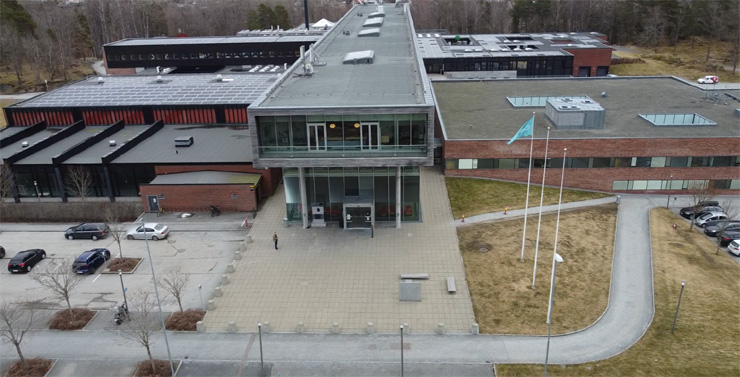
Erasmus+ Education for sustainability and resilience
Learning, teaching, and training event
Østfold University College, Norway
18th -20th January, 2023
Østfold University College (HiØ), Halden, Norway
This learning, teaching, and training event was held in the teacher education department at HiØ. The event included a combination of lectures and workshops that focused on aesthetic elements in the Storyline approach, assessment, and the challenges of interdisciplinary teaching and learning. Competency in interdisciplinary approaches is vital to support the complexity of teaching and learning for sustainability and resilience.
The main goal of each teaching and learning event for this project is to highlight what is unique in the Storyline approach and how this uniqueness will support teaching and learning about issues of sustainability. The department of teacher education at HiØ has been working interdisciplinarily through the Storyline approach for several years, and thus provides for a solid venue of experience for interdisciplinary teaching and learning. This event aimed to add the perspectives of researchers, student teachers, and teacher educators. Researchers and teacher educators at HiØ along with practitioners from participating schools provided the content for the workshops.
The goals for the event in Norway, 2022 where the following:
Tangible outcomes from the Norwegian Event included the following:
JANUARY 18th Day 1
We where welcomed to HiØ by English Special Educator Gini Lockhart-Pedersen and the Director of the National Center for English and Foreign languages in Education, Steinar Nybøle and Program leader for Teacher Education HiØ, Lin Sandhaug Ramberg. Then we listened to the Coordinator of the Project Erasmus + Education for
sustainability and resilience Eva Marsh who gave us an update on the progress of the project.
Session one focused on Creating a Storyline "setting" with the use of sound and was lead by Gini Lockhart-Pedersen. (Goal 1,6) We created a sound orchestra that played the sounds of one day in a Storyline setting and we discussed how we all can use this in our Storyline work.
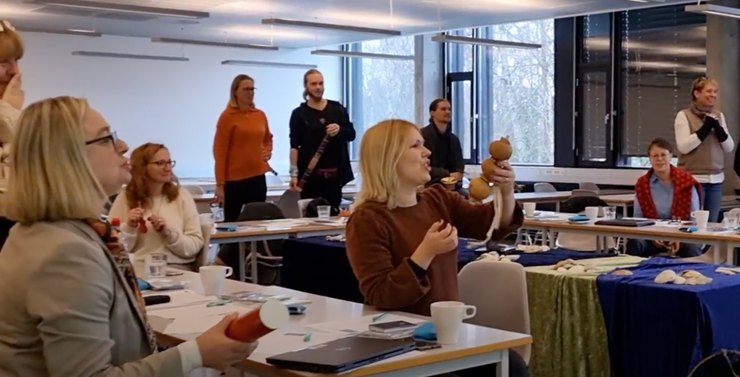
One participant wrote in the evaluation "This was a great experience! Often studen teachers hesitate when they hear that we will work with music during a Storyline session, so working with sounds was a very good way to bring in auditive elements. It was also very inpiring - we came up with many ideas how to follow up this workshop and put it into actions in various ways. I will definitly use this next time I conduct a Storyline." Another one wrore: "The sensory of sound is often forgotten. This workshop helped give a framework for working with sound in any storyline." To integrate all subjects and to work interdiciplinary demands good structure and some teachers have difficulties in integrating aestetic elements in their storyline in a structured way. One participant wrote: "These tips need to be spread because I think that the topic of music usually has a hard time fitting into a storyline."
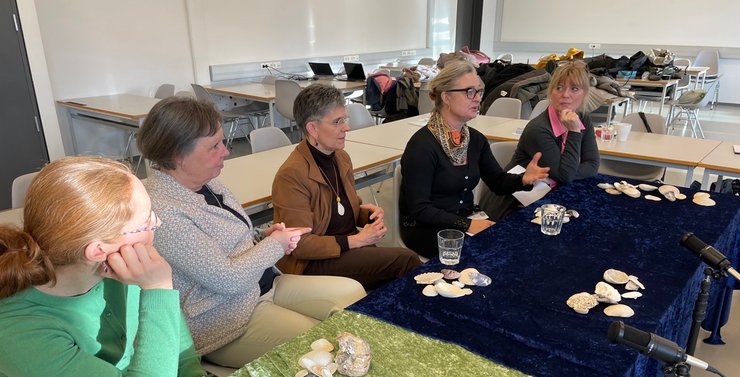
During session two (goal 2,3,4,6, and Tangible outcomes, video film) the researchers in the project Hanne Eik Pilskog, Ann-Catherine Henriksson, Virginia Lockhart-Pedersen, Gitte Cecilie Motzfeldt and Margaretha Häggström to lay the ground for next days filming. It was very interesting for the other participants to hear what the results of the research has shown so far. The reflections from the teachers after the session shows how important it is for teachers to work together with researchers to develop new and better ways of teaching. Some reflections as examples: "
It was interesting to hear new perspectives on student teachers' experiences of a Storyline. It was also very informative about sustainable development and democratic values. Sometimes we forget that education for sustainable development should not just be about knowledge developing or fostering the students to act in certain predeterminated ways, but to be pluralistic. It was good to hear about this from an expert."
"I like the fact that we now have a kvantitative studie that measures students learning in Storyline mixed with sustainable development."
"Interesting to hear about Ackes studies where she has seen that the students develop empathy during Storyline work"

We then took part of a lecture held by Solvig Toft (goal 1) who gave us an artist´s perspective on the project at HiØ and talked about how to work interdisciplinary at the college level. How can we define the subject of art in storyline work and how do we work with sustainability and the storyline products? Can we focus more on reusing the outcomes?
Some reflections afterwards:
"That it is important to have professionals to integrate professions in a good way."
"I think it is more difficult to put together an interdisciplinary work when there are many different subject teachers who have to include as many parts of their subject as possible. It is easy for each subject to become its own island with its own aims and objectives. In an interdisciplinary working method, the common purpose and goal need to be the same and each subject needs to see what they can contribute to reach the purpose and goal."
During session 4 (goal 3,5) we suddenly experienced the smell of bad fish during the coffee-break. Gini, Gitte and Hanne then lead us in an excercise to show how you can use teacher in role to create incidents in a storyline. We then reflected on the challenges of planning for interdixciplinary teaching and learning.
The evaluation stated:
"It was a good experience to take part of how the teachers can act when in role, and what that means for the students experiences.It was inspiring and gave us a lot to discuss."
"The basis is a will and a belief that the student learns from a holistic perspective and a courage to dare to let go of his own subject and dare to believe in teaching where we acquire knowledge based on skills. This can be a challenge if the teacher is fighting for his own. I think close cooperation is required"
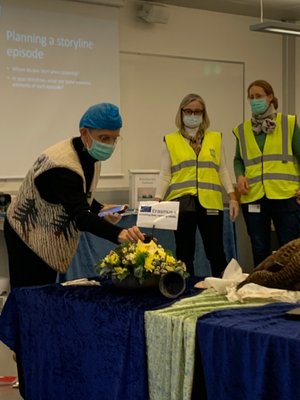
"Smell is also a sensory that we need to use. Strong smells create a context for feelings and emotions."
"Maggan mentions that in order to succeed in working with Storyline, you need to understand that there must be a story within a storyline. It is the events that help us create the common thread. It is through the events that we can arouse emotions, create motivation that can then lead us to the understanding of the factual knowledge."
"I think we need to give the student´s suggestions of incidents more space in our storylines"
"Accentuated the importance of the teachers going into role"
Reflection on day one showed that the participants had got a deeper understanding for the importance of the aestetic elements and how they are integrated and used in our storylines.
"Aesthetic work is one of the features that other cross-curricular do not always include. I think this is one way to include multimodality for real in a storyline, and that it is o crucial way to evoke emotions. It is a way to work from an affective pedagogical approach. According to learning theories, aethetics have an important role to play concerning students incentives and motivation. Without the aesthetic elements there is no storyline."
"The workshops and presentations during this event gave a more professional depth to using aesthetics in storyline."
"Aestetic elements help us to live into the place, events and characters of the story. Extremely important.Shortcuts to emotions. Make characters more alive."
We then reflected on the challenges of planning for and working with interdisciplinary teaching and learning for sustainability and resilience. This way of teaching needs a professional group of teachers with a common goal that can work together and see the benefit of integrating all subjects. It can be easier done in schools where fewer teachers teach more subjects so you are not so many involved. Reflections contained:
"We need skilled teachers - both when it comes to the subjects and also in pedagogy and didaktics."
"The basis is a will and a belief that the student learns from a holistic perspective and a courage to dare to let go of his own subject and dare to believe in teaching where we acquire knowledge based on skills. This can be a challenge if the teacher is fighting for his own. I think close cooperation is required"
"this can be hard working with older students, while easy working in primary school were the teachers are interdiciplinary and have more opportunities to use whole days with a children"
We then visited the fantastic old Fredrikshalds teater from 1838 and got a guided tour.
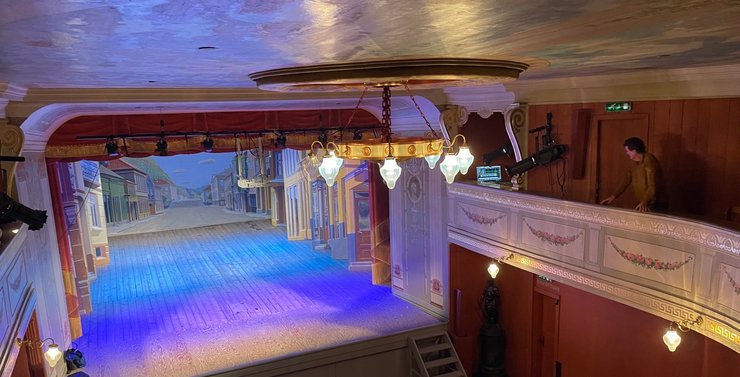
JANUARY 19th Day 2
In the morning of day two we met Gunhild Brænne Bjørnstad who gave us an introduction to how you can introduce charachters through drama. She had prepared a lot of shoes and hats that we could use to "get into charachter". We had a lot of fun during the session. Gunhild and Gini then told us about their experiences during the pandemic when they where forsed to work with digital charachters since the students had to stay at home.
“Everything we did was applicable on all levels. All we did was reflected upon, which I think is essential in our understandings. Also, the end discussion was important.”
“A reminder of including emotions...the feelings of a charachter when developing them.”
“A nice workshop with easy ways of integrating drama that can involeve more students and feelings in the storylines.”
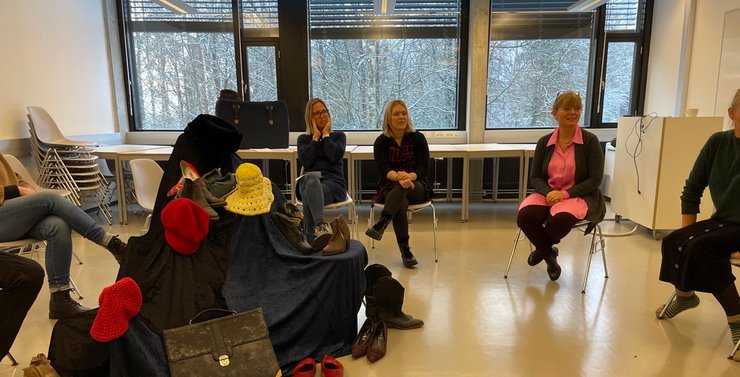
Next session we focused on the evaluation tool (goal 5,6) and we were lead by Anna Johansson and Ann-Catherine Henriksson. Acke showed us the website for the evaluation tool and Anna went through some of the “bubble” sheets that they are working with at Backatorpsskolan. Reflections by participants: “It was good to recapitulate and grasp the tool, and how we can move forward. It still needs some concretiation work, and I think it is good to discuss this tool many times, to really understand how to use it. I think it is growing well, and that it really looked useful.“
“The idea of our bubbles is so right. Our bubbles agree well with what the researchers have concluded that by working with sustainability through Storyline, we train many of the competencies that Green Comp covers.”
The participants were also clear that there is quite some work to be done before the evaluation-tool is ready.
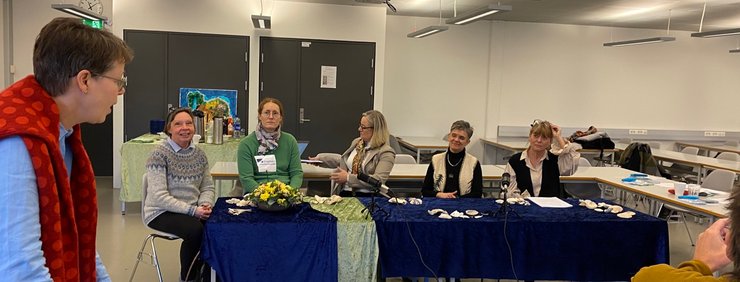
Then the discussion with the researchers continued and proved to be important for the participants understanding of both what researchers can bring out in the open and about storyline as a method.
“I was delighted with the overall results that emerged through the project. What I took to heart the most was that I found many connections around our work with GreenComp, which reinforces that Storyline is a good method to work with when it comes to sustainability issues.”
“Maggan's research is important for us to convey to teaching teachers the importance of relational pedagogy and also the teacher's active role during a Storyline. I also take with me the importance of teaching to arouse emotions because emotions arouse motivation and motivatoíon makes learning more effective.”
The rest of day was used to film intervievs with the researchers to produce the video while the rest of the participants worked with the assessment tool.
In the evaluation after the event the following question was given to the participants:
Please - summarise and reflect on the outcomes from the Reserch order to explore how the Storyline approach may facilitate learning and acting on issues of sustainability that engage the learners in various ways. What do our researchers think is most important for developing the work with Storyline and sustainability? What do practicing teachers and administrators think?
This is the outcome:
In the evaluationform we also asked the participants In what ways they can see that students learn about sustainable development through storyline work?
One participant summarizes his experience of the entire project with those words:
It has been instructive for me to be involved in the whole process and see how all the pieces of the project fall into place, I see how the Stockholm Days 18-19 October 2021 October became the basis for the entire project. How what we learned there about the importance of emotions, the vulnerability of our planet and urgent problems, from Phanu and Pella and Ylva's workshop with the characters, has followed our discussions and work throughout the project. And how, via Slovenia's work and our films from the Katarinaskoan retreat and the university, the importance of the Storyline method has grown stronger and where we in Turku got to grips with how we should try to make visible the development of knowledge in sustainability issues is connected to a whole in Halden where we see that the research supports Storyline and other interdisciplinary working methods in sustainability issues. What a trip!
Other voices states:
The project as a whole has developed me as a person in terms of sustainability and resilience. I have gained more knowledge and I have undergone and am undergoing processes for how my life will become more sustainable. I ride around on Kubler's curve of change.
From this teaching and learning, I haven't changed a mind set, but have developed further the mind set that the project has created... the mindset of understanding sustainability as complex... and emotional.
During these days, I have been strengthened in how important it is that teaching must take place as a whole and that teaching must arouse some kind of feeling in order for learning to take place more effectively. I will take this with me in future planning of the theme work.
The next question was: What do you think has been the project's impact so far on the participants, participating organisations, target groups and other relevant stakeholders?
One important thing with our project is to spread the outcomes to people and organizations outside the project which is done through the multiplier events and the website but the participants spread the results outside of these set events and places. The students in university and in schools have been involved and taken part in the project and collegues that are not directly involved in the project have been informed and have shown interest. Discussions have occurred within the Storyline community and workshops have been held outside the project on other schools. The researchers have presentet their work at conferences and in discussion groups. One participant also reflects: “regarding the knowledge of living a sustainable life, I have had many discussions with family, relatives and friends in a completely different way than I did before I became part of this project.”
The next upcoming event is the multiplier event in Gothenburg. Before that we need to publish several articles on the research done on the website. We also have one film to produce about the research and the assessment tool needs some more work before it can be published. But the project is going according to plan and we think that we all have gained a lot from participating.
Participants, representing the partners in Erasmus + Strategic Partnerships for school education
Backatorpsskolan, Sweden. Eva Mars, Anna Johansson, Jessica Hansson, Oliver Jönsson, Torbjörn Nyberg, Storyline Sverige, Sweden Håkan Källqvist, Ylva Lundin
University of Gothenburg, Sweden. Margaretha Häggström
Østfold University College, Norway. Virginia Lockhart-Pedersen, Gitte Cecilie Motzfeldt, and Hanne Eik Pilstedt.
Åbo Akademi University, Finland. Ann-Catherine Henriksson
Osnovna šola Ob Rinži Kočevje, Slovenia. Katja Ilc Virant and Mateja Vidrih
The European Commission's support for the event does not constitute an endorsement of the contents, which reflect the views only of the authors, and the Commission cannot be held responsible for any use which may be made of the information contained therein.
The European Commission's support for the production of this publication does not constitute an endorsement of the contents, which reflect the views only of the authors, and the Commission cannot be held responsible for any use which may be made of the information contained therein.